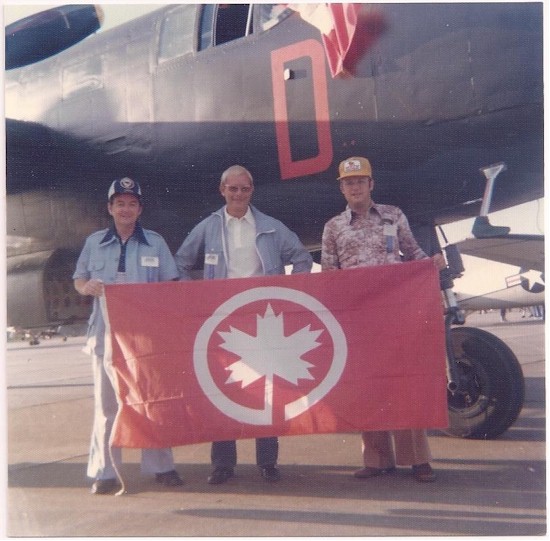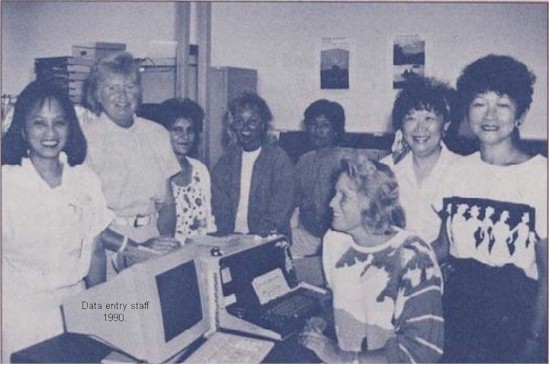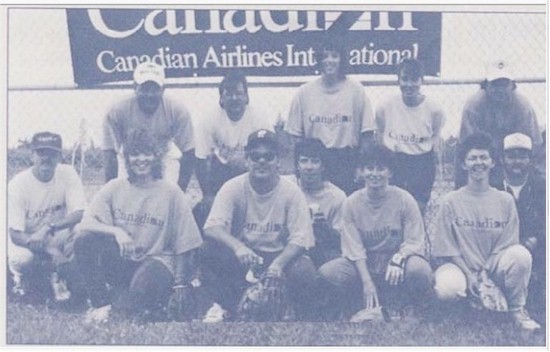|
Found in 'Horizons' magazine |
|
Issue dated June 1984 |
|
A history of CF-TCC. Enclosed with the issue of Horizons dated June 1984 was an insert describing the various exciting plans to celebrate the company's 50th anniversary, starting in 1986. One of them, involving the coast-to-coast flight of a Lockheed L-10A began last January when Captain Ray Lank brought the aircraft back from Florida. CF-TCC has returned to its original owner to be used as part of Air Canada's 50th anniversary celebrations. The ten-seat Lockheed L-10A flew Trans-Canada Air Lines inaugural flight between Vancouver and Seattle on September 1, 1937. |
 |
|
The key to the aircraft and its log book were handed over to Air Canada in Florida prior to the flight to Canada. From the left are: Captain Ray Lank; Al Scammel, Chief Inspector, Aircraft, Dorval; TCC owner Bud Clark and Ernie Sykes, a former Air Canada employee who discovered the airplane in Florida. The Pionairs had advance notice of this project at their recent Annual General Meeting in Anaheim when guest speaker Captain Lank talked about the project. Here are some of his remarks which appeared in the 'Horizons' magazine issued June 1984. Our first leg was about four hours to Memphis, Tennessee. I was struck by two facts - I could see the strobe effect on the props, and I could actually look out and see the wings and engines. It all felt right, and looked right, and even smelled right with AV-gas perfume. Second day took us into colder and colder weather, crisp and clear and looking good for a 'one-fuel-stop' then a direct to Winnipeg operation, just as Flight Dispatcher Bill Sansom had planned. When we dropped into Omaha, the old L-10A was a little chilly to say the least. On landing roll out the right brake gave up the ghost in sheer annoyance at these decidedly un-Florida like temperatures! We did a slow-and-over' so our welcoming team could have a look. Then we landed, and breaking all rules, taxied into the hangar itself. A brief ceremony took place where I accepted the aircraft key and log book on behalf of the company. I then sent a teletype to the V.P., Flight Operations which read: 'CF-TCC safely home - the adventure has begun.' Three months later when I saw the aircraft again, it was no longer in flying condition. The maintenance crews had wasted no time in taking it apart. The engines have gone to Pratt & Whitney for zero timing by them as their contribution to the event. The interior and cockpit were literally stripped and even the wide twin tall was off. When the work is done, however, the L-10A will look like a genuine 1937 aircraft right down to the Trans-Canada Air Lines lettering on the silver-tone fuselage. In fact those of us flying the machine will even be dressed circa 1937. Tentatively, the flight visitation program will begin April 10, 1986 and end up in Vancouver at Expo '86." |
|
Editors' Note: Additional NetLetter articles referring to CF-TCC - |
|
Netletter #1378 issued November 2017, Roger Slauenwhite sent this information - Since CF-TCC is airborne again for the 80th anniversary, here is a picture of the three people who 'discovered' the original L-10A aircraft in Harlingen, Texas at the Confederate Air Force airshow. It was flown in from Plant City, Florida. |
 |
|
On the left is Roger Slauenwhite, retired Sales Manager and Pionair, Bob Rathwell, Sales Manager (now deceased) and Ernie Sykes, Airport Personnel. CF TCC (at this time had an American registration) was parked directly behind this B-25, flown in for the show from Hamilton, Ontario. On our return to YYZ we advised Ted Morris in Toronto P.R. of our finding. Ted called Montreal P.R. and set the wheels in motion. The rest is history. Ted was instrumental in making this all happen (a good P.R. man). Otherwise this aircraft might still be flying freight around the southern United States, which was its previous task. Hats off to Ted Morris. Roger Slauenwhite |
|
Netletter #1380 issued December 2017, David Edward has sent this information he received from Paul Sanchez after the CF-TCC article appeared in NetLetter #1378. "Dave, that certainly brings back some wonderful memories for me and I am quite impressed with the story of your family history. You are probably familiar with the CF-TCC, the Lockheed 10-A that Air Canada purchased in 1984. The attached pic is of me in 1977 stripping all of the paint off of 'er! Of course, that was 40 years ago and I had a little more hair. What a way to start off in aviation! I was 17 and you can see the brown spot underneath the wing which was Turco paint stripper. I stripped the paint off most of the airplane myself and that was not much fun for a 17 year old, but it paid off when we later found, etched into the aluminum skin, the letters: CF-TCC. |
 |
|
Memories by CF-TCC by Peter Larsen, excerpt from Airways magazine July 1999. I enjoyed Tango-Charlie-Charlie (May 1999) about the Lockheed L-10A Electra and thought you might like some additional information about her past. I knew CF-TCC in the late seventies and early eighties when she was registered NC3749 and owned by M. P. 'Bud' Clark of Plant City, Florida. She was finished in overall bare metal with US Army Air Corps markings. Bud flew her annually to Harlingen, Texas, for the Confederate Air Force show and participated in the EAA Sun 'n' Fun Fly-In at Lakeland, Florida. During this time, he kept the aircraft at Lakeland Municipal (now Lakeland Linder Regional), where I rode my bicycle on weekends to help him out. |
|
Submitted by Ed Copeman, retired Air Canada captain - While reading the latest issue of "The Netletter" and seeing the letters BOAC, a story came to mind. I spent quite a few years flying from Dorval, became a second-officer instructor during that time, and that is where (and when) I was told this story. It was a 'dark and stormy' day at CYUL, and a BOAC B-707 was doing a non-precision flight to runway 24R. Through a 'hole' they spied the runway, and stuffed it down to that runway, flared for landing 'chopping' the power and touching down hard only to discover that the runway was nowhere near as long as the approach-chart mentioned! Full reverse, maximum brakes and the B-707 came to a halt near the western end of R/W 24 at Cartierville; not at Dorval which is several miles further west! BOAC flew in a new crew of supervisory pilots to ferry that B-707 to Dorval, and since then... BOAC came to mean Been Over At Cartierville, tho' not any BOAC pilots ever repeated that! Yours truly, Ed Copeman |
|
Editor's Note from Terry Baker: Hello Ed, Thank you for taking the time to send us this item which we will pass along to our readers. BOAC could always be Better On Air Canada. There is also an instance when an Air France aircraft landed at Cartierville in error. |
|
Viewing the article on the Viscount in NetLetter #1508 prompted Louise Ingram to send this comment - Thank you for the article on the Viscount. It brought up so many fond memories for me. I started my career with Air Canada as a stewardess in March 1966 and was based in YWG. My favourite aircraft to work on was the Viscount. I’ve visited the Winnipeg museum and the museum in Sidney, B.C. which both have a Viscount. Love it! Louise Ingram |
|
Neil Burton has sent us an excerpt from the Kamloops Sentinel issued June 28, 1950. One of the most recent businesses to take up its headquarters in Kamloops in 1950 is Central British Columbia Airlines, with its base at Fulton Field Airport, Kamloops, B. C. The work of Central B.C. Airways constitutes the constant vigil against forest fires, servicing of mining properties in Central and Northern B.C. and taking charter flights to any point in Canada. The company operates 11 modern type aircraft, from bases at Kamloops, Penticton, Prince George, Fort St. James, Burns Lake and Nelson. It also owns and operates Kamloops Air Services, providing charter service, to lakes and resorts of the Kamloops fishing, hunting and ranching district. Under the direction of F. Russell Baker, hero of many a mercy flight in the central and northern interior, the newly acquired Kamloops business will undoubtedly expand with the progress of the Central and northern interior. Pilot Baker is one of the few persons not of American citizenship ever to receive the United States Air Medal, presented to him by President Harry S. Truman for dramatic rescue of crews of three American bombers forced down in the north country during the war. This ambitious company at present operates 3 de Havilland Canada DHC-2 Beavers, 2 Junkers freighters, 1 Fairchild 71C, 2 Republic RC-3 Seabee amphibians and 2 Cessna T50's. In personnel, experience and equipment, the company is ready at all times to handle freight or passenger service anywhere in the country. Source: Kamloops Sentinel issued June 28, 1950 via Neil Burton. |
|
Editors' Note: Between 1949 and 1952, Central British Columbia Airlines acquired seven other smaller flying services. With each acquisition, the company expanded its base of operations, providing the much needed manpower and equipment necessary to maintain a rapidly expanding air service. These companies included Associated Air Taxi, Kamloops Air Service, Skeena Air Transport, Whitehorse Flying Services and Port Alberni Airways. In 1953, the company adopted the name Pacific Western Airlines. Acquired Queen Charlotte Airlines and Associated Airways in 1955. Acquired BC Airlines in 1970 and merged with Transair in 1979. Source: airlinehistory.co.uk/airline/central-british-columbia-airlines/ |
|
We are looking forward to what promises to be an exciting event, building on the traditional excellence of our conventions as reflected in our rewarding and successful gathering at Winnipeg in 2022. The convention opens with a Meet and Greet on Wednesday evening. Reconnect with your friends and meet aviation enthusiasts from across Canada at this informal evening. On Thursday a bus will take us to Trenton, Ontario, where we will tour Canada's largest air force base and the National Air Force Museum of Canada. The CC-177 Globemaster, the CC-150 Polaris, the CC-130J Hercules, and the CH-146 Griffon are all based at Trenton. We are also planning a tour of the air force museum, featuring one of the only two restored Handley Page Halifax bombers. The museum also features an extensive air park of retired RCAF aircraft. Click Here for full details and registration. |
 for the latest posts at the Air Canada Media Centre. for the latest posts at the Air Canada Media Centre. |
 Click the logo to open the Air Canada YouTube channel. Click the logo to open the Air Canada YouTube channel. |






